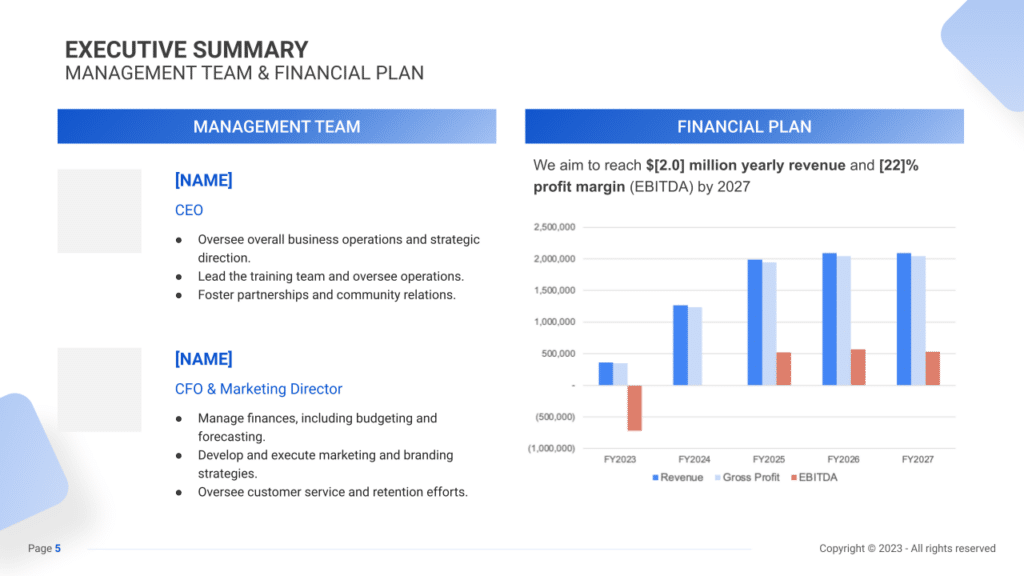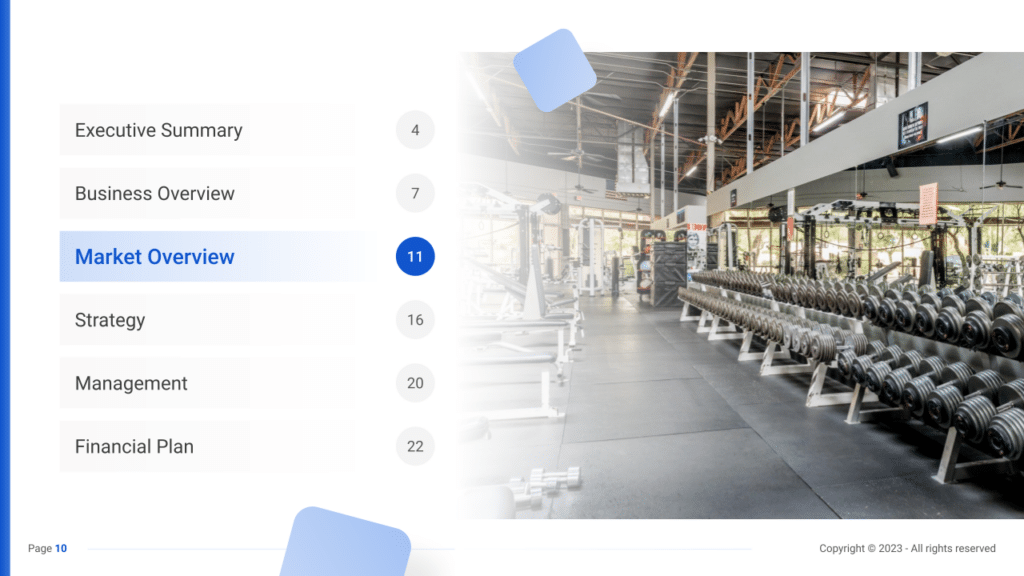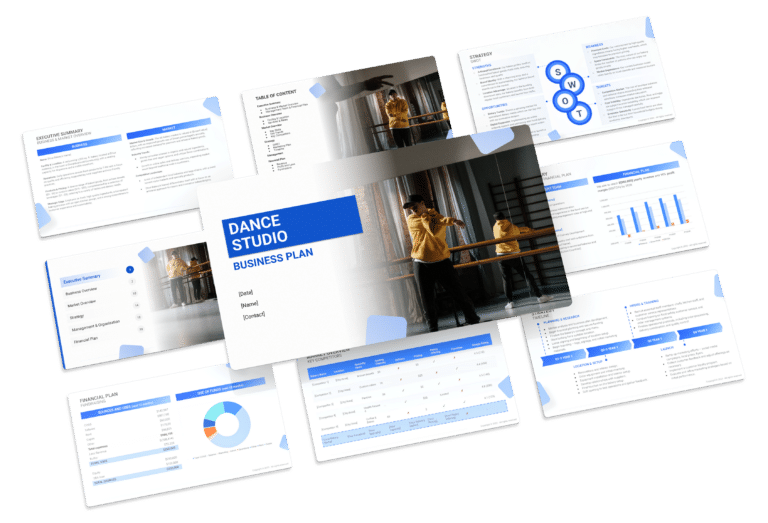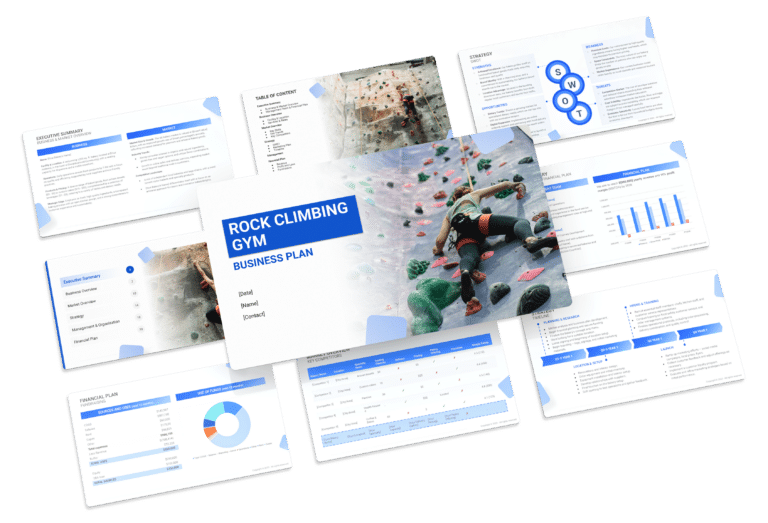Gym Business Plan Template & PDF Example

Creating a comprehensive business plan is crucial for launching and running a successful gym. This plan serves as your roadmap, detailing your vision, operational strategies, and financial forecasts. It helps establish your gym’s identity, navigate the competitive market, and secure essential resources for growth.
This article not only breaks down the critical components of a gym business plan, but also provides an example of a business plan to help you craft your own.
Whether you’re an experienced entrepreneur or new to the fitness industry, this guide, complete with a business plan example, lays the groundwork for turning your gym concept into reality. Let’s dive in!
The Plan
Our gym business plan follows a clear and straightforward structure, covering all the important areas you need in a business plan. Below are the key sections of our business plan:
- Executive Summary: a quick look at your gym, its market landscape, management and financial plan.
- Business Overview: detailed info on what your gym offers and its operations:
- Facility, Amenities & Equipment: what your gym looks like, what equipment it has, and its features.
- Location & Accessibility: where your gym is and why it’s a good location for potential customers.
- Memberships & Classes: types of memberships and classes available (as well as prices)
- Market Overview: dives into the fitness market, who are the key competitors in the vicinity and how they compare vs. your business:
- Key Stats: the industry size, growth and some recent important statistics on the gym industry.
- Key Trends: the recent market trends defining and driving the gym and fitness industry (regulation, customers trends, etc.)
- Key Competitors: who are your key competitors in the area and how they compare vs. your business.
- Strategy: how the gym plans to grow and attract members:
- SWOT: strengths, weaknesses, opportunities, and threats.
- Marketing Plan: how you intend to attract and retain members / customers.
- Timeline: major steps and goals from starting up to growth (12 months minimum plan)
- Management: who runs the gym and what they do.
- Financial Plan: the expected 5-year financial performance of your gym (revenue and profits), as well as how much you expect to spend.

Executive Summary
The Executive Summary introduces your gym’s business plan, offering a brief look at your gym and its goals. It should cover your gym’s combination of fitness and wellness services, top-notch equipment, variety of membership plans, and prime location.
This section should also highlight how your gym fits into the broader gym market, how many direct competitors you have and who they are, as well as your unique selling points.
Finally, you should also include here details on the management and co-founding team (who they are and what they do), as well as a summary of your financial projections (5-year revenue and profits are enough).
Gym Business Plan Executive Summary Example


Business Overview
In the business overview, you should clearly define your gym’s characteristics. This includes its name, location, facility details, membership plans, and the variety of classes offered. This part of the summary is critical for showcasing what makes your gym stand out in a competitive fitness industry.
Example:
For instance, “FitFusion Gym,” situated in the city center, offers a 15,000 sq. ft. space with an open-plan design and state-of-the-art equipment. Its unique selling points include a comprehensive range of fitness classes, from HIIT to Yoga, and premium amenities like a wellness center. These features position FitFusion as a versatile and appealing fitness destination.
Market Overview
In this section, you should analyze the gym market, including its size, growth trends, and key competitors. This gives context to where your gym fits within the industry and highlights how it can capitalize on current fitness trends.
Example:
FitFusion Gym enters a robust U.S. market valued at $30.8 billion. It sets itself apart from the five main competitors in its vicinity by offering a blend of holistic wellness and cutting-edge fitness technology, tapping into the growing demand for integrated health and fitness experiences.
Management Team
Detailing the experience and roles of your management team is vital. This section should highlight their qualifications in gym and wellness management, underscoring their ability to drive the gym’s success.
Example:
The CEO of FitFusion brings extensive experience in fitness management, guiding the gym’s strategic direction and operations. The CFO & Marketing Director, with a strong background in finance and marketing, plays a crucial role in managing the gym’s finances and developing effective marketing strategies to enhance customer engagement and retention.
Financial Plan
A clear presentation of financial goals and projections is key in this section. It should include targets for revenue and profit margins, offering insight into the gym’s financial health and growth prospects.
Example:
With a target of $2.0 million in yearly revenue and a 22% profit margin by 2027, FitFusion Gym is positioned for significant growth. Its financial strategy is supported by an ambitious marketing approach and a focus on delivering exceptional customer experiences, aligning the gym for success in the competitive fitness market.
Business Overview
For a gym, the Business Overview section succinctly covers three critical components:
Facility, Amenities & Equipment
Detail the gym’s layout, showcasing a wide range of equipment for cardio, strength training, and flexibility exercises. Highlight unique amenities such as sauna rooms, personal training services, and on-site nutritionists that contribute to a holistic fitness environment.
Location & Accessibility
Describe the gym’s location, emphasizing its convenience for members, whether it’s close to residential areas, business districts, or has ample parking and public transport links. The aim is to illustrate how the gym’s location is strategically chosen to fit seamlessly into members’ daily routines.
Memberships & Classes
Explain the variety of memberships and classes available, catering to different preferences and schedules. Focus on the inclusivity of fitness programs, from beginner to advanced levels, and any unique offerings like group fitness classes, yoga sessions, or specialized training workshops that differentiate your gym from competitors.


Market Overview

Industry Size & Growth
In the Market Overview section of your gym business plan, start by assessing the gym industry’s size and anticipated growth. This evaluation provides an understanding of the market’s potential and the opportunity for new entrants.
Key Market Trends
Next, discuss recent market trends, such as the increasing consumer focus on holistic health, incorporating both physical and mental wellness practices. For example, highlight the rising popularity of gyms offering a variety of fitness options, from traditional weightlifting to wellness classes like yoga and meditation, catering to a broader audience seeking comprehensive health solutions.
Competitive Landscape
A competitive analysis is not just a tool for gauging the position of your gym in the market and its key competitors; it’s also a fundamental component of your business plan. This analysis helps identify your gym’s unique selling points, essential for differentiating your business in a competitive market.
In addition, competitive analysis is integral in laying a solid foundation for your business plan. By examining various operational aspects of your competitors, you gain valuable information that ensures your business plan is robust, informed, and tailored to succeed in the current market environment.
Identifying Your Competitors in the Gym Industry
To begin the analysis, it’s imperative to identify and categorize local competitors. These encompass a spectrum of fitness establishments, including renowned chain gyms, specialized boutique studios, community-based fitness centers, and even online workout platforms. The competitive landscape extends beyond direct gym-to-gym rivalry, incorporating alternative fitness options like outdoor boot camps, virtual training programs, or home workout subscriptions.
Leverage digital tools and platforms such as Google Maps, Yelp, or industry-specific directories to map out competitor locations. Simultaneously, dive into customer reviews and ratings to gauge the strengths and weaknesses of rival gyms. For instance, positive feedback on “Peak Performance Gym’s” personalized training sessions highlights a competitive edge worth considering.

Gym Competitors’ Strategies
Analyzing the strategies of your competitors encompasses various facets:
A thorough examination of competitor strategies involves a multi-faceted approach:
- Fitness Offerings: Scrutinize the array of fitness services and programs offered. If “Mindful Movement Studio” gains traction with mindfulness-based workouts or niche programs like aerial yoga, it signals a trend towards holistic fitness approaches.
- Training Methodologies: Consider the diverse training methodologies adopted by competitors. A gym like “Strength & Conditioning Hub,” focusing on functional fitness and group classes, may attract a different demographic than “Cardio Fusion Fitness,” known for its cardio-centric programs.
- Pricing Structures: Conduct a comparative analysis of membership fees and pricing models vis-à-vis competitors. Are your rates in alignment with the budget-friendly options of “EconoFit” or more akin to the exclusive memberships at “Premier Fitness Retreat”?
- Marketing Strategies: Evaluate the marketing initiatives deployed by rival gyms. Are they heavily invested in social media campaigns, influencer partnerships, or local community engagement events?
- Member Experience: Analyze the holistic member experience provided by competitors. For instance, “Rejuvenate Wellness Center” might stand out for its holistic approach, offering nutritional counseling, spa facilities, and group therapy sessions in addition to workouts.
- Operational Efficiencies: Observe if competitors leverage technology for member engagement, facility management, or workout tracking. For example, “Virtual Vitality Gym” might excel in offering live-streamed classes and personalized virtual coaching.
What’s Your Gym’s Unique Value Proposition?
Crafting a distinct value proposition is pivotal for setting your gym apart. Identify your gym’s strengths and core offerings. It might specialize in cutting-edge equipment, an exclusive training methodology, or a diverse array of classes catering to all fitness levels.
Continuously gather member feedback and analyze industry trends to identify unmet needs or evolving preferences. For instance, an emerging interest in sustainability might prompt your gym to adopt eco-friendly practices or organize outdoor workout sessions to align with this trend.
Additionally, consider your gym’s physical location and its demographics. A gym nestled in a tech-centric neighborhood might emphasize digital fitness innovations, while one in a family-oriented community could prioritize childcare services and family-friendly programs.
Strategy

SWOT
First, include here a SWOT analysis to identify the gym’s Strengths (such as cutting-edge equipment or a prime location), Weaknesses (like high operational costs or stiff competition), Opportunities (for example, a growing interest in fitness among the local population), and Threats (such as economic downturns affecting customer spending).

Marketing Plan
Then, adding a marketing plan is another crucial component, detailing how the gym will attract and retain members through targeted advertising, promotions, social media engagement, and community events.
Marketing Channels
Leverage a mix of marketing channels to engage with potential and existing gym members.
Digital Marketing
- Engage on Social Media: Utilize platforms like Instagram, Facebook, and Twitter to share workout tips, success stories, and gym events. Foster an online fitness community through regular engagement.
- Email Marketing: Cultivate an email list and send newsletters featuring fitness advice, class updates, and promotional offers to keep members engaged.
- Website and SEO: Develop a user-friendly website showcasing gym amenities, class schedules, trainer profiles, and client testimonials. Optimize for local SEO to boost visibility in searches.
Local Advertising
- Harness Local Marketing: Distribute flyers in nearby neighborhoods, participate in community events, and invest in local media advertising to expand your gym’s reach.
- Host Community Events: Organize fitness challenges, open days, or charity events to engage with the community and showcase your gym’s offerings.
- Partnerships: Collaborate with health-related businesses or local establishments for mutual promotion and referral programs.
Promotional Activities
- Offer Attractive Deals: Launch promotional campaigns like ‘New Year Fitness Challenges’ or ‘Summer Transformation Programs’. Provide trial memberships or discounts for new sign-ups to attract potential members.
- Loyalty Programs: Implement rewards for long-term members, offering perks like free classes or merchandise after a certain number of visits to foster member retention.
- Referral Incentives: Encourage existing members to refer new clients by providing discounts or free sessions as rewards, boosting word-of-mouth marketing.

Sales Channels
Efficient sales strategies within your gym are crucial for revenue generation and maintaining member satisfaction.
In-Gym Upselling
Optimizing revenue during every member visit:
- Personal Training Add-Ons: Encourage members to explore additional services such as personal training sessions, nutrition consultations, or specialized fitness assessments during gym visits or membership sign-ups.
- Supplementary Gear: Showcase fitness accessories like resistance bands, foam rollers, or heart rate monitors, highlighting their benefits for enhancing workout routines. Ensure staff are well-versed in product knowledge to assist members in making informed purchases.
- Tailored Membership Packages: Present customized membership upgrades such as VIP access to exclusive gym areas, extended class schedules, or priority booking for sought-after sessions to cater to diverse member preferences.
- Complementary Add-Ons: Offer complimentary sessions or trial classes for new equipment, workout programs, or group fitness sessions, encouraging members to explore and possibly opt for extended services.
Online Booking and Sales
- Online Booking System: Design an intuitive and user-friendly website or mobile app for seamless membership purchases, class bookings, and payments.
- Integration of Payment Systems: Incorporate secure payment gateways, allowing for hassle-free transactions and offering various payment options.
- Membership Customization: Enable members to personalize their memberships by choosing preferred services, class types, or add-on packages during the online signup process.
- Automated Notifications: Implement automated confirmation emails or text messages upon successful bookings, ensuring members receive timely reminders.
- Virtual Consultations: Introduce virtual fitness classes or on-demand workout videos accessible through the online platform, catering to members’ preferences for at-home workouts.
Membership and Loyalty Programs
Encourage repeat business and foster member loyalty:
- Membership Options: Provide tiered membership levels with varying services, amenities, and pricing to cater to different member preferences.
- Loyalty Rewards: Develop a digital loyalty program where members earn points for each visit, referral, or participation in gym activities, redeemable for discounts on services or merchandise.
Strategy Timeline
Finally, a well-defined timeline sets clear milestones for the gym’s launch, marketing campaigns, membership growth, and expansion goals, ensuring that the business progresses with purpose and direction.

Management
The Management section focuses on the gym’s management and their direct roles in daily operations and strategic direction. This part is crucial for understanding who is responsible for making key decisions and driving the gym towards its financial and operational goals.
For your gym business plan, list the core team members, their specific responsibilities, and how their expertise supports the gym’s mission.


Financial Plan
The Financial Plan section is a comprehensive analysis of the gym’s financial strategy, including projections for revenue, expenses, and profitability. It lays out the gym’s approach to securing funding, managing cash flow, and achieving breakeven.
This section typically includes detailed forecasts for the first 5 years of operation, highlighting expected revenue, operating costs and capital expenditures.
For your gym business plan, provide a snapshot of your financial statement (profit and loss, balance sheet, cash flow statement), as well as your key assumptions (e.g. pricing strategies for memberships and services, etc.).
Make sure to cover here
_ Profit and Loss
_ Cash Flow Statement
_ Balance Sheet
_ Use of Funds









